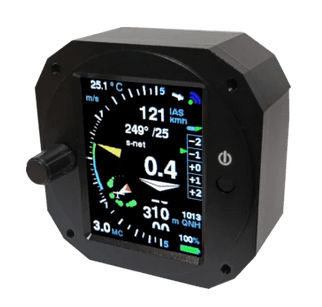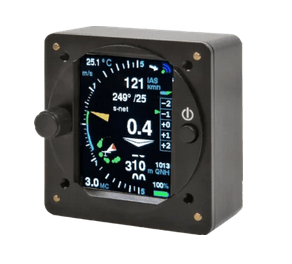XCVario User Manual #


XCVario 57mm and 80mm
Series: All
Software Version: Latest
Manual edition 3.04
info@xcvario.de
Other versions of earlier software statuses at: https://github.com/iltis42/XCVario/tree/master/handbook
General #
The XCVario is a modern digital and smart variometer with wired serial and wireless interfaces to any navigation display or with applications such as XCSoar, LK8000 and more, as well as wired interfaces to a GPS source, a FLARM, an OpenVario or other devices. It has modern, high-resolution digital sensors for pressure, acceleration and temperature, an expansion tank as is usual with older systems is no longer required.
The XCVario is connected to the TE nozzle pressure, the static and the dynamic pressure, and compensated either conventionally via the TE nozzle or electronically. It has an audio function via its own built-in 2 watt speaker.
The forward-thinking Kalman filter offers a quick response to changes with good smoothing of the vario display, without the usual delay of a few seconds, which is known from simple damping. The Vario shows exactly what you feel. The Vario can also be adjusted according to personal preferences via the setup with many setting options.
From the 2021 series, the load factor (n) is taken into account when calculating the current sink value from the polar coefficient using an acceleration sensor, because the increased load factor requires more lift from the profile with the same aircraft mass (difference to higher ballast). This increases the drag coefficient and this leads to increased sink rates. In a standard class aircraft, for example, with a load factor of 2 g, this results in about twice the sink rate. This is not insignificant and is taken into account in the net vario, which significantly improves the net vario display, especially in the case of dynamic processes (pull up, push down) compared to conventional devices without the corresponding sensors.
Optionally, a FLARM or another source for NMEA (GPS) data can be connected to the XCVario, the Vario not only forwards this data to XCSoar, tasks can also be declared on an (IGC) FLARM with XCSoar, settings made and the flight can then be read out. Clubs can operate the device with its many options in the “Student Mode”, which allows users to only modify the 5 most important settings such as QNH, MC, etc.
The standard installed and freely available software of the XCVario (https://github.com/iltis42/XCVario) offers many features. In addition to a vario display, speed with MacCready setting, there is a precise altimeter, a wind indicator, a charge level indicator for the battery, a temperature indicator and more. The flap display, which can be switched on as an option, can display the flap position using an external sensor and provides information on the optimal flap position depending on the wing loading, the speed and the load factor. Thanks to a growing library of more than 100 polars for a wide variety of glider types, the vario can be adapted to almost any glider. Since the software is publicly available on github, developers can clone the software and further develop their own features and ideas, and also deliver them.
In addition to the independent function, the Vario can exchange data with the software running there via the wireless interface either via Bluetooth or wireless LAN (WLAN, WiFi), or via the RS232 (-TTL) interface, depending on which interface the device used has . The wireless standards ensure secure and stable transmission and have the advantage that there is no need for hardware-related and sometimes complex cabling with the navigation device.
Thanks to the high resolution of the digital, temperature-compensated and factory-calibrated pressure sensors, even the smallest height differences of just 8 cm are detected. Properties such as accuracy, reliability and long-term stability are therefore given. The sensor for the dynamic pressure or speed or IAS enables an absolute accuracy of better than 1%, at 100 km/h the deviation is a maximum of 1 km/h.
The outside temperature can be measured with the digital temperature sensor in the ventilation area to 0.5° Celsius with a resolution of 0.1° Celsius, and is included in the calculation of the TAS (True Airspeed) as an atmospheric parameter for determining the air density.
The exact flight speed, as well as the temperature and TE vario values, can be used to calculate precise values for the target flight. The precise altimeter without hysteresis allows final approach altitudes to be calculated appropriately in XCSoar, because the wind calculation in XCSoar and now also in the XCVario itself works reliably and precisely together with a GPS source.
It is very easy to operate and is done using the rotary (rotary knob) with Push&Turn (press and turn), next to it there is a button to switch it on. The system, which is manufactured in large numbers, is an excellent replacement for old vario systems with many additional modern features.





Kann das gesamte online-Dokument als PDF gespeichert werden.
Eine offline-Version des Handbuches ist hilfreich, wenn z.b. auf einem Flugplatz keine Internetverbindung besteht.
Danke für den Hinweis.
Mit freundlichen Grüssen
Daniel Trümpi
Die multilinguale Online Dohumentation des XCVario kann kapitelweise als PDF gespeichert werden über den Print Button (als pdf Speichern).
(1) Ein ganzheitliches pdf-Document (wie es schon einmal zur Verfügung stand) wäre ein großer Vorteil !(Seitenummern zum Nachschlagen, Index, ausdruckbar etc.).
(2) Eine Änderungsdokumentation, d.h. ab welcher Softwareversion stehen welche Merkmale/Merkmalsveränderungen zur Verfügung, wäre sehr nützlich.
(1) Kapitelweise lässt sich das Handbuch selbstverständlich ausdrucken, alle Kapitel in einen Dokument sind aktuell leider nicht möglich, eventuell bietet das Plugin dies zu einem späteren Zeitpunkt
(2) Die Änderungsdokumentation zu jeder Software-Version findet sich hier: https://github.com/iltis42/XCVario/releases, das Online Handbuch gilt jeweils immer für die aktuelle Version